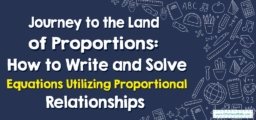How to Use Tables to Write Proportional Relationship Equations

proportional relationships describe two quantities that increase or decrease at the same rate. For example, if you travel at a constant speed, the distance you travel is proportional to the time you spend traveling.
A Step-by-step Guide to Using Tables to Write Proportional Relationship Equations
If you have data that are in a table and you believe the data represents a proportional relationship, you can write an equation to describe that relationship. Let’s take it step-by-step:
Step 1: Identify the relationship
The first step is to check if the quantities in your table actually have a proportional relationship. In a proportional relationship, the ratio between the two quantities is constant. You can check this by dividing the numbers in one column by the numbers in the other column. If you always get the same number, then the quantities are proportional.
For example, consider the following table:
| Time (hours) | Distance (miles) |
|---|---|
| 1 | 50 |
| 2 | 100 |
| 3 | 150 |
| 4 | 200 |
If we divide the distance by the time, we get \(50\) for each row. This indicates a proportional relationship.
Step 2: Find the constant of proportionality (k)
In a proportional relationship, we can express the relationship as \(y=kx\), where k is the constant of proportionality. We found out from the above step that \(k=50\) for our example.
Step 3: Write the equation
Now that we know the constant of proportionality, we can write an equation to represent this relationship. For our example, since “Distance” is proportional to “Time”, and the constant of proportionality is \(50\), the equation would be: Distance \(=50 \times\)Time.
This equation says that for each hour (Time), you will travel \(50\) miles (Distance).
Step 4: Use the equation
Now that we have our equation, we can use it to predict values that weren’t in our original table. For example, if we want to know how far we would travel in \(5\) hours, we could substitute \(5\) for Time in our equation and calculate: Distance \(=50 \times5=250\) miles.
Related to This Article
More math articles
- Top 10 Tips to Overcome CLEP College Algebra Anxiety
- Rules of Exponents
- The Ultimate ACT Math Formula Cheat Sheet
- Top 10 Free Websites for ISEE Math Preparation
- How is the TABE Test Scored?
- ACT Math: Everything You Need to Know
- How to Estimate Products of Mixed Numbers
- Accuplacer Math FREE Sample Practice Questions
- Write a Ratio
- 3rd Grade WVGSA Math Worksheets: FREE & Printable
























What people say about "How to Use Tables to Write Proportional Relationship Equations - Effortless Math: We Help Students Learn to LOVE Mathematics"?
No one replied yet.